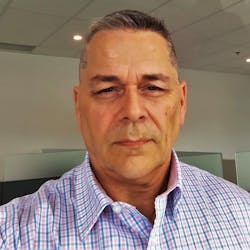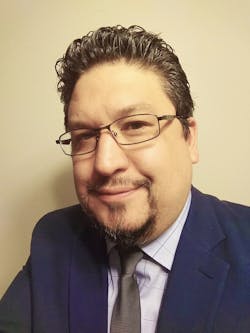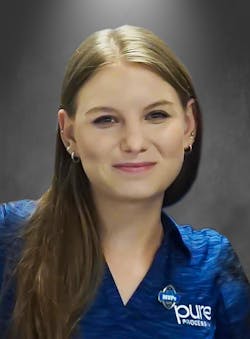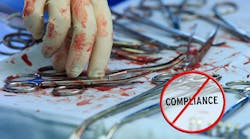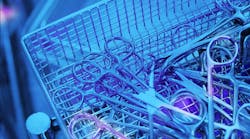The pressure on sterile processing (SP) teams to reprocess thousands of surgical instruments each day safely, effectively and efficiently can be overwhelming. Cleaning is by far the most critical step in surgical instrument reprocessing. The effective removal of bioburden establishes a safe path for sterilization. Each instrument must be cleaned in accordance with its manufacturer’s instructions for use (IFU). While many instruments are approved by the manufacturer for automated cleaning methodologies, others, such as fragile or difficult-to-clean instruments, must be cleaned manually.
On top of understanding and adhering to instrument manufacturer IFUs during the cleaning process, SP professionals must also understand the cleaning equipment and chemistries they are using and abide by the IFUs of those manufacturers as well. HPN asked manufacturers of SP cleaning equipment and supplies to share best practices that SP teams can employ for both manual and automated instrument cleaning.
Lead with education and training
An SP professional responsible for cleaning the constant flow of different instruments arriving in the department post-procedure requires vast knowledge to identify each instrument and know how to clean it in accordance with its manufacturer’s IFU. As Nancy Fellows, MSN MPA RN CNOR, ASP Sr. Clinical Education Consultant, pointed out, the implementation of best practice aligned with manual or automated device instrument cleaning begins with education.
Improve access to IFUs
Fellows stressed the importance of following manufacturer IFUs when cleaning instruments, citing the Association of periOperative Registered Nurses’ (AORN) Guidelines for Perioperative Practice, which states, “review the instrument manufacturer’s written IFU to determine the requirements for replicating the validated cleaning and processing methods.”1
But she acknowledged how these “critical resources” are not always readily available to SP teams, stating, “Compliance with the manufacturer’s IFU must be adhered to, to ensure that a device is cleaned properly. In many instances, IFUs are not available or are unfamiliar to SPD techs. It is paramount to have IFUs at one’s fingertips.”
“I bolded committed instead of complying because committed staff will comply and make the effort to ensure a quality outcome is achieved,” he explained. “Simply asking for compliance leaves the door open for minimum or even lack of compliance.”
To help drive decontamination IFU compliance, Kimsey recommends use of BLUEfin software, which he says provides real-time decontamination guidance to the technician at the sink while calculating, communicating, and documenting IFU details through the dashboard.
He stated, “STERIS utilizes the software at their off-site reprocessing centers in Durham and Chattanooga, ensuring the highest levels of compliance and commitment to quality, and it works! Staff feel confident they are following the IFU and no longer worry about memorizing or guessing what to do. The software also helps to accelerate staff training and long-term education.”
Dig down into the details
As instruments become more complex in design and more difficult to clean, Seth Hendee, CSPDT, CFER, CRCST, CIS, CER, CHL, IAHCSMM Approved Instructor, Clinical Education Specialist, Healthmark Industries, recommended SP professionals become more detailed in their work.
Take advantage of available resources
He stated, “I think the best advice that I could give to SPD technicians for device and instrument cleaning is to use the tools they have at their disposal to assist them in ensuring clean and safe devices for patients. In the old days, we didn't have things like borescopes or cleaning verification tests to assist us, so we cleaned lumens as best we could, and we passed them along to the next step in the process.”
Okada continued, “Imagine if a laboratory technician ‘did their best’ to assess a blood sample instead of using their machines and technology to assist them. We need to start thinking of ourselves more as ‘decontamination detectives,’ and using our tools and technology to ensure devices are safe before moving them forward to the next step in the process.”
Measure for cleaning efficacy
Wilder said, “The use of cleaning indicators and tools to evaluate the effectiveness of cleaning cannot be underestimated in ensuring that manual and automated cleaning are effective at removing patient soil from reusable instruments. Each washer, with each different rack, should be evaluated for this when placed into service by placing multiple indicators at multiple locations in the chamber to determine the/these location/s.”
He added, “The process should be customized for wash cycle durations to ensure that these process challenge locations are effectively cleaned. This should be done with the most difficult-to-clean indicators, since an easy pass is no way to provide patient safety. The same sort of testing should be done for ultrasonics, especially those with multiple levels.”
According to Wilder, while other measures of cleaning efficacy, like ATP or residual protein, are very useful for training staff in manual cleaning, “visually clean is no longer good enough.”
He pointed out, “If the staff learns how much more cleaning is required after visual cleanliness is achieved, the number of unclean loads returned from the OR will decrease as will HAIs.”
Automation is no substitute for hands-on cleaning
Pietura urged SP teams to assess technologies that enhance these cleaning practices and combine their washer-disinfectors and ultrasonics with automated systems to replace manual cleaning methods (syringes and spray guns) at the sink.
“Consider automated, hands-free flushing systems that focus on enhanced flushing and volume for all devices, not just for endoscopes,” said Pietura.
Key areas for cleaning improvements
Experts interviewed for this article highlighted the following areas of the instrument-cleaning process where best practices could be put to the best use.
Leverage tools for lumened devices
“Lumened devices present a challenge to both types of processing because direct friction, that lifts soil away from a surface, is difficult to provide in lumens. The longer and narrower the lumen, the harder that becomes,” Hendee explained.
When working with SP teams, Hendee said he “consistently sees a ‘one-size-fits-all’ mentality about the selection of cleaning brushes available in decontam.” He added that while “nearly every washer manufacturer makes specialty racks and/or manifolds for flushing lumens during the wash cycle,” he sees “these washer accessories in serious disrepair or not being used at all in many facilities.”
Hendee noted, “Attention to detail in brush selection and use will be the difference between whether the cleaning is effective or not. The same attention is needed in automated cleaning of lumens. These tools must be maintained and used with care and focus if they are to help us clean these long channels well.”
Don’t skimp on the soak
“I teach best practice in cleaning starts with an enzymatic soak,” said Kimsey. “As simple as it sounds, I often find variation in soaking and lack of IFU compliance that it’s worth talking about. Soaking loosens the bioburden from the instruments surface and improves subsequent cleaning activities such as flushing and brushing and automated washing. I’m surprised how many people start flushing and brushing first or at the beginning of the soak time instead of allowing the water and enzymes to do their job and loosen the bioburden.”
Rinse to remove residue
“If instruments are poorly rinsed, detergent residue can develop, creating a dull coating on the instrument’s surface or if tap water is used for final rinsing, spotting can occur from mineral deposits,” said Willoughby. “Once these residues develop, the chance of them becoming chemically active during the sterilization process is high and will in turn accelerate corrosion.”
He added, “By establishing (or improving) regular education, training and support, these types of ‘reprocessing’ errors can be avoided, and will lead to consistent and higher levels of practice in surgical instrument care in the CD/SPD.”


